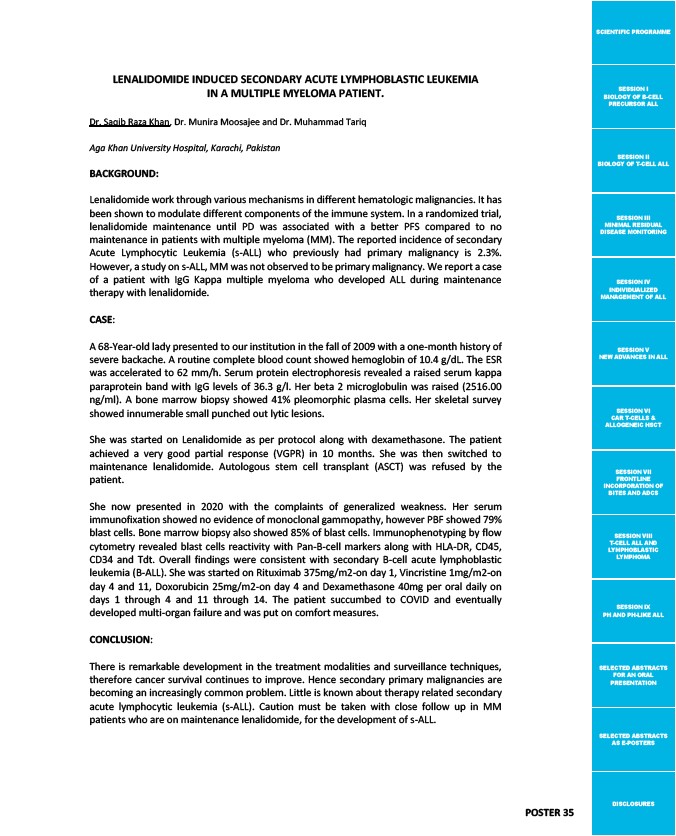
SCIENTIFIC PROGRAMME
SESSION I
BIOLOGY OF B-CELL
PRECURSOR ALL
SESSION II
BIOLOGY OF T-CELL ALL
SESSION III
MINIMAL RESIDUAL
DISEASE MONITORING
SESSION IV
INDIVIDUALIZED
MANAGEMENT OF ALL
SESSION V
NEW ADVANCES IN ALL
SESSION VI
CAR T-CELLS &
ALLOGENEIC HSCT
SESSION VII
FRONTLINE
INCORPORATION OF
BITES AND ADCS
SESSION VIII
T-CELL ALL AND
LYMPHOBLASTIC
LYMPHOMA
SESSION IX
PH AND PH-LIKE ALL
SELECTED ABSTRACTS
FOR AN ORAL
PRESENTATION
SELECTED ABSTRACTS
AS E-POSTERS
DISCLOSURES
LENALIDOMIDE INDUCED SECONDARY ACUTE LYMPHOBLASTIC LEUKEMIA
IN A MULTIPLE MYELOMA PATIENT.
Dr. Saqib Raza Khan, Dr. Munira Moosajee and Dr. Muhammad Tariq
Aga Khan University Hospital, Karachi, Pakistan
BACKGROUND:
Lenalidomide work through various mechanisms in different hematologic malignancies. It has
been shown to modulate different components of the immune system. In a randomized trial,
lenalidomide maintenance until PD was associated with a better PFS compared to no
maintenance in patients with multiple myeloma (MM). The reported incidence of secondary
Acute Lymphocytic Leukemia (s-ALL) who previously had primary malignancy is 2.3%.
However, a study on s-ALL, MM was not observed to be primary malignancy. We report a case
of a patient with IgG Kappa multiple myeloma who developed ALL during maintenance
therapy with lenalidomide.
CASE:
A 68-Year-old lady presented to our institution in the fall of 2009 with a one-month history of
severe backache. A routine complete blood count showed hemoglobin of 10.4 g/dL. The ESR
was accelerated to 62 mm/h. Serum protein electrophoresis revealed a raised serum kappa
paraprotein band with IgG levels of 36.3 g/l. Her beta 2 microglobulin was raised (2516.00
ng/ml). A bone marrow biopsy showed 41% pleomorphic plasma cells. Her skeletal survey
showed innumerable small punched out lytic lesions.
She was started on Lenalidomide as per protocol along with dexamethasone. The patient
achieved a very good partial response (VGPR) in 10 months. She was then switched to
maintenance lenalidomide. Autologous stem cell transplant (ASCT) was refused by the
patient.
She now presented in 2020 with the complaints of generalized weakness. Her serum
immunofixation showed no evidence of monoclonal gammopathy, however PBF showed 79%
blast cells. Bone marrow biopsy also showed 85% of blast cells. Immunophenotyping by flow
cytometry revealed blast cells reactivity with Pan-B-cell markers along with HLA-DR, CD45,
CD34 and Tdt. Overall findings were consistent with secondary B-cell acute lymphoblastic
leukemia (B-ALL). She was started on Rituximab 375mg/m2-on day 1, Vincristine 1mg/m2-on
day 4 and 11, Doxorubicin 25mg/m2-on day 4 and Dexamethasone 40mg per oral daily on
days 1 through 4 and 11 through 14. The patient succumbed to COVID and eventually
developed multi-organ failure and was put on comfort measures.
CONCLUSION:
There is remarkable development in the treatment modalities and surveillance techniques,
therefore cancer survival continues to improve. Hence secondary primary malignancies are
becoming an increasingly common problem. Little is known about therapy related secondary
acute lymphocytic leukemia (s-ALL). Caution must be taken with close follow up in MM
patients who are on maintenance lenalidomide, for the development of s-ALL.
POSTER 35